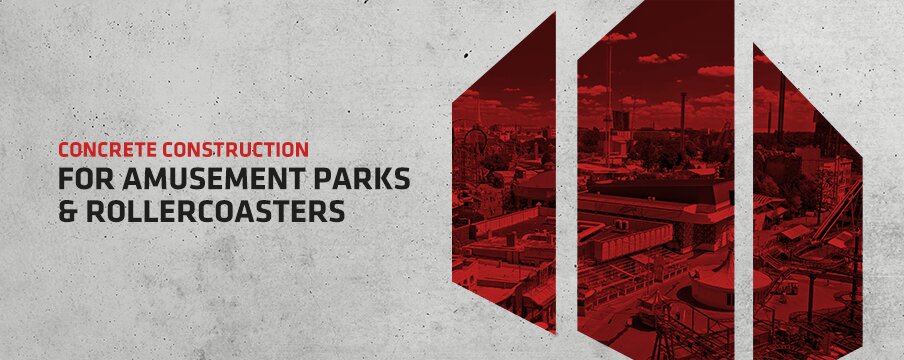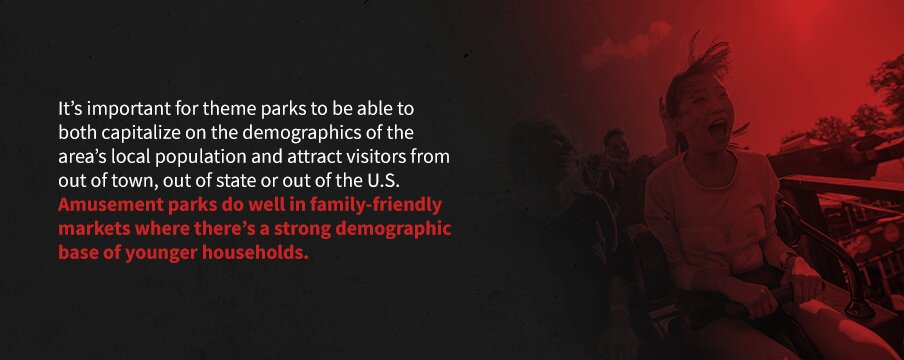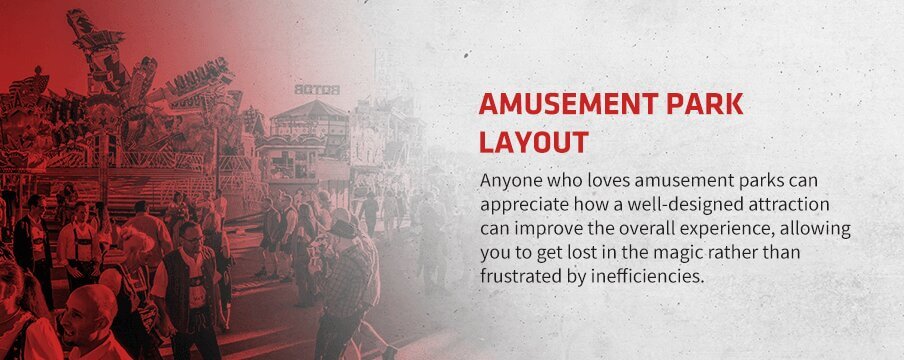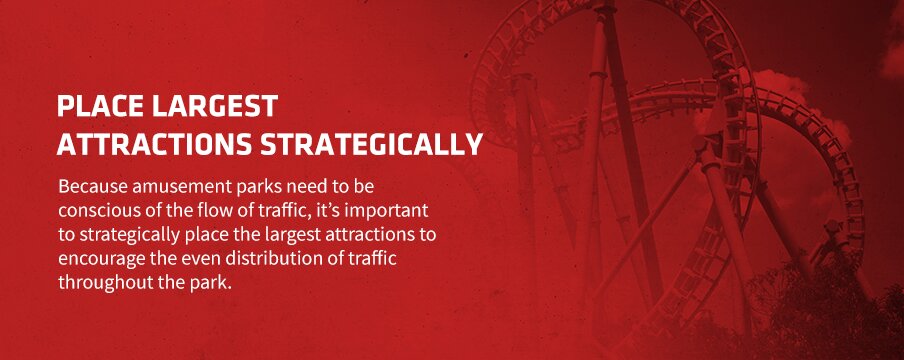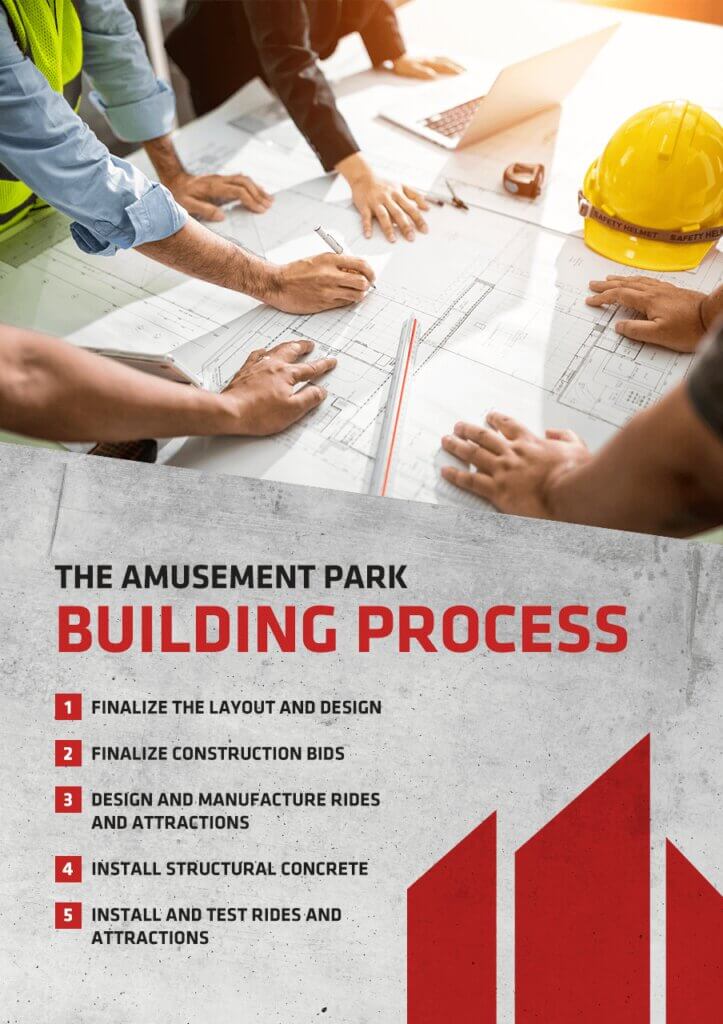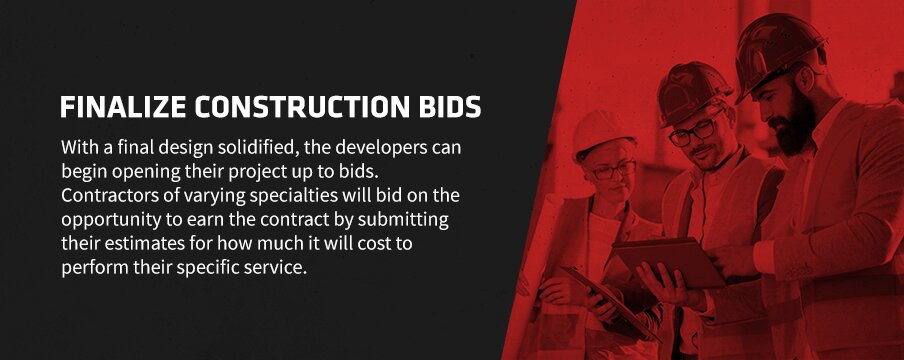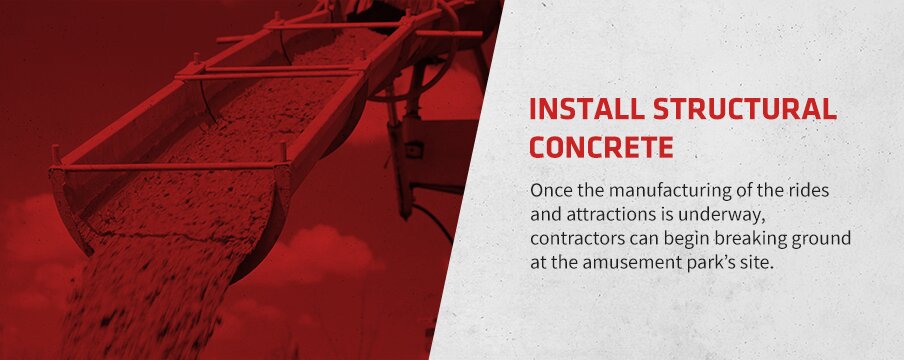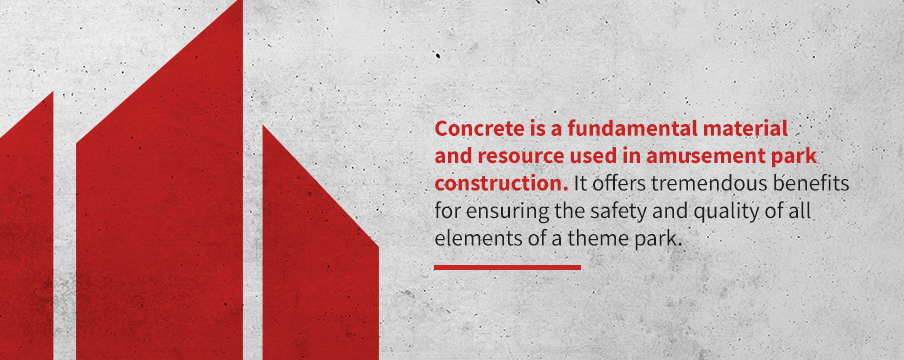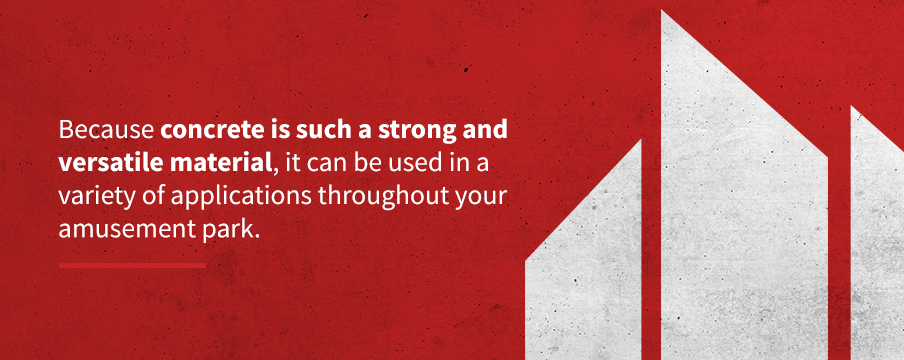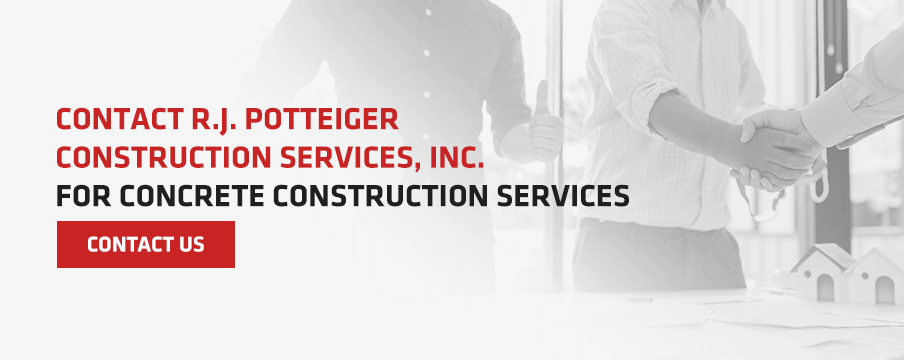Concrete Construction for Amusement Parks & Rollercoasters
The amusement park market is steadily growing thanks to new innovations and technologies making themed rides more engaging and interactive. According to the Amusement Parks Global Market Report, the global amusement park market value grew to $106.57 billion USD in 2023 and is projected to reach $122.50 billion by 2027. This substantial and steady growth means that municipalities and venture capitalists have a strategic investment opportunity they can capitalize on with the development of new theme park construction.
There’s a lot that goes into the construction of a theme park. Specialized experts in fields like mechanics, chemistry, materials engineering and construction technology all work together to successfully and safely build a theme park. However, perhaps the unsung hero of all amusement parks and roller coasters is the concrete material used to support and shape the park’s landscape and structure. Without concrete, the amusement park wouldn’t take form and wouldn’t be safe for visitors to freely interact without worry or inhibition.
In this guide, we’ll uncover how theme parks are built, including the role that concrete plays in bringing rides and attractions to life.
HOW AMUSEMENT PARK SITES ARE SELECTED
When we think of classic American amusement park locations, the obvious one that comes to mind is Orlando, Florida. It’s safe to assume that Orlando became the world’s theme park capital because of its climate and year-round vacation weather — but that’s not the only thing the city has going for it. There are several factors that developers look at when choosing an amusement park site to determine whether it will be a viable business investment. Here are some of the considerations for theme park locations:
Climate
Disney is one of the most well-known theme parks, with locations in Anaheim, CA, and Orlando, FL, but there are plenty of other theme parks throughout the rest of the country. Six Flags operates hugely popular theme parks in the Midwest and Northeast and even has a location in Montreal, Quebec. Amusement parks in areas with all four seasons typically don’t operate a full year-round schedule. They go full swing in the summer and scale back operations to weekends-only in the colder months. Some of these parks capitalize on the holiday season, turning their parks into festive family celebrations that honor the beloved time of year.
Population
An amusement park’s location must have the population to support it to establish a solid market base. Generally, theme parks are located within highly urbanized areas with populations of several million people or more. However, building a new theme park in metropolitan areas means there will also be more competition as other entertainment businesses seek to capitalize on the same customer base. Urban areas also command higher labor costs. Services are also costlier in big cities, making operating a park expensive.
Demographics
Even if a location has millions of people, it’s also important to consider the demographics of the epicenter. Different visitors of different ages are drawn to amusement parks for different reasons. Theme parks need to be able to both capitalize on the demographics of the area’s local population and attract visitors from out of town, out of state or out of the U.S.
Amusement parks do well in family-friendly markets where there’s a strong demographic base of younger households. However, the aging baby-boomer population is also a major driver in amusement park visits, making more retirement-oriented centers attractive for park developers. Consider the lifestyles, income levels, age distribution and accessibility requirements for people in the area and visitors when deciding on a suitable location for a new theme park.
Transportation
Amusement parks must rely on their ability to draw in visitors from all over the place if they want to thrive. This means that the theme park’s location needs to be accessible by multiple transportation methods. Disney World’s location is in a prime spot between two major Orlando highways — Interstate 4 and the Florida Turnpike. It’s important to establish an amusement park that’s easy for locals and residents of the surrounding areas to drive to and conveniently park for the day. It’s also vital for the amusement park to be near an international airport that can service out-of-country visitors and connect them easily to the theme park.
With various transportation options available around your amusement park’s area, you have a better chance of attracting more visitors because they can reach the park more easily.
Tourism support
To make an amusement park successful, you want to encourage visitors to return for multiple days rather than a short one-day visit. The amusement park’s location must have the surrounding tourism infrastructure to support and encourage multi-day vacations while attracting people from out of town. When people visit from out of town, they need an ample selection of hotels or vacation rentals. They also need restaurants, shopping centers and other forms of entertainment to make a longer stay worthwhile. Again, it’s essential to consider the trade-off between these ideal location attributes and the potential for competition.
When choosing a location for your potential amusement park, it’s important to weigh the pros and cons. Some decision factors will carry more weight, meaning you may need to prioritize them more than others when deciding on a site. Once you’ve identified the right location for your amusement park, the next step is to determine how extensive the park will be and how it will be strategically developed to attract a wide variety of visitors.
AMUSEMENT PARK LAYOUT
Anyone who loves amusement parks can appreciate how a well-designed attraction can improve the overall experience, letting you to get lost in the magic rather than frustrated by inefficiencies. Designing a theme park is part art, part science. It requires developers to bring a creative vision to life within the confines of the physical site, local regulations and other restrictions and factors.
An amusement park’s layout should be based on strategy, safety and encouraging people to stay and enjoy themselves for as long as possible. The top 25 theme parks worldwide saw a combined attendance of 198.70 million visitors in 2022. With how normal it is for amusement parks to see tens of thousands of visitors each day, they must have a layout and design that prioritizes safety while still being easy to navigate and enjoy. When developing your amusement park layout, here are some key factors to keep in mind:
- Promote the flow of traffic: One of the most critical tenets of proper amusement park layout is the ability to promote and control the flow of traffic. The layout should allow visitors to follow clearly defined concrete paths and walkways but not limit traffic so much that it creates bottlenecks, congestion and hoards of crowds. Theme park visitors should spread out throughout the park naturally to prevent clogs at particular attractions in certain park sections. Finally, a well-laid-out theme park should also intuitively guide visitors to major attractions while keeping them away from park operation spaces they aren’t meant to wander into.
- Consider the accessibility of visitors: Roughly 12% of adults in the U.S. have a mobility disability that affects their ability to move around with ease, such as walking or climbing stairs without difficulty. Amusement park designers must make conscious decisions about accessibility to ensure people with disabilities can still enjoy attractions during their visit. If certain attractions are designed around narrow pathways or stairwells, it’s critical that there also be wide concrete sidewalks and rampways available to accommodate wheelchairs, walkers and other assistive devices. Parks should also make it clearly known where wheelchair-accessible points are so people with disabilities know which attractions are accessible.
- Place largest attractions strategically: Amusement parks need to be conscious of traffic flow, so it’s essential to strategically place the largest attractions in areas that encourage an even distribution of traffic throughout the park. Generally, the park’s largest attractions are placed towards the middle or back of the park. This placement encourages people to flow through shopping, restaurants, concession and other ancillary services to generate increased revenue.
- Plan for high-capacity queues: Nothing deters visitors from staying and enjoying their time at an amusement park like the perception of impossibly long line-ups. Over the years, many amusement parks have come up with solutions to line-ups by offering the ability to pay more for priority ride boarding. However, most visitors don’t upgrade their passes because they prefer to save money by waiting in line. Therefore, park designers must ensure that each attraction can accommodate significant queues. When designing the amusement park layout, keep in mind the queue capacity that each attraction needs. It should be small enough to avoid taking up valuable park real estate, but long enough to accommodate peak periods without queues spilling into the general park area.
- Put safety first: Safety should be the most important focus for all amusement park operators. Safety measures should be thoroughly planned and accounted for in the park’s layout. While there can only be one entry point, the park must have a plan for emergency exits — both from the attractions and the park itself. Wide, flat, solid concrete pathways and walkways can accommodate many people if an emergency does happen. With multiple arteries and exit points, it minimizes the risk of choke points and the inefficient funneling of crowds in emergencies.
THE AMUSEMENT PARK BUILDING PROCESS
It takes a long time to build amusement parks. From initial designs to the final construction of each ride, it can take years before the theme park opens to the public. Each ride and attraction can take up to three years to design and manufacture. The building process for amusement parks is complex and consists of several phases.
First, the developers need to finalize the design and acquire the piece of land. Then, the amusement park needs permits and approvals from various levels of government. Once approved, the actual construction process can begin. The following is an overview of each general step in the amusement park building process:
- Finalize the Layout and Design
- Finalize Construction Bids
- Design and Manufacture Rides and Attractions
- Install Structural Concrete
- Install and Test Rides and Attractions
1. FINALIZE THE LAYOUT AND DESIGN
Amusement park designs need to be as comprehensive as possible in order to turn a vision into reality. The design will determine critical aspects that direct the construction process, including:
- Where each ride or attraction gets constructed.
- How many overall rides and attractions the amusement park is going to be home to.
- Supplies, materials and equipment that are needed to build the amusement park.
- Experts and professionals needed to ensure the amusement park gets built properly.
- Any additional resources that are required to finalize the amusement park for opening day.
The design and layout determine the building process and the overall budget. For the project to fall within the budget, the design will typically go through multiple iterations until the total projected cost falls in line with the financial resources allocated for the amusement park.
2. FINALIZE CONSTRUCTION BIDS
With a final design solidified, the developers can begin opening their project up to bids. Contractors of varying specialties will bid on the opportunity to earn the contract by submitting their estimates for how much it will cost to perform their specific service. Bidding contractors may also recommend to the amusement park developers how to perform certain aspects of construction, including which materials, supplies and equipment to use and how to ensure that the project adheres to building and safety codes. Amusement park developers select the winning bid from the submitted proposals and create contracts with the businesses or contractors before construction begins.
3. DESIGN AND MANUFACTURE RIDES AND ATTRACTIONS
Ride and attraction manufacturing is a highly specialized field. There are ride and attraction manufacturers who contract with amusement park developers to design, build and install the assets for the amusement park. With the developer’s guidance, the ride and attraction manufacturers come up with designs that match the vision or theme of the park. The amusement park owner signs off on the design, and the manufacturer gets to work building the rides and attractions that will eventually be installed at the park. This process can take years, depending on how complex the design is.
4. INSTALL STRUCTURAL CONCRETE
Once the rides and attractions are manufactured, concrete construction for amusement parks can commence. Contractors can begin breaking ground at the amusement park’s site. When the land is ready, contractors can install the structural foundations and elements throughout the park, where the rides and attractions will eventually be set up.
Rides and attractions need infrastructure and support set in place before they can be installed, for safety and structural purposes. Working with the ride manufacturers, contractors and structural engineers will design and finalize the concrete foundations for theme park rides. Throughout the park, concrete foundations for rides, attractions and other park amenities will be framed, poured and cured, prepping them for installation.
During this phase, other necessary concrete for amusement parks will be poured. Concrete plays a major role in framing spaces and providing structure for multiple attractions, rides and other park elements, such as:
- Pathways
- Staircases
- Ramps
- Courtyards
- Plazas
- Other surface areas
Any ancillary buildings, like restaurants, cafes and shops, will also require concrete foundations and framing, depending on local building codes.
5. INSTALL AND TEST RIDES AND ATTRACTIONS
The final step in the amusement park building process is to install and test the rides. The ride and attraction manufacturer will ship the assets in pieces to the amusement park site. The installers will carefully assemble each ride and attraction piece by piece, and the amusement park will begin to take shape. The rides and attractions then undergo rigorous testing to ensure safety well ahead of opening day. The rides and attractions are then subject to multiple rounds of inspections before being approved for public use.
BENEFITS AND APPLICATIONS OF CONCRETE FOR AMUSEMENT PARKS
Concrete is a fundamental material and resource used in amusement park construction. It offers tremendous benefits for ensuring the safety and quality of all elements of a theme park. It provides structural integrity for theme park rides and attractions so they can be properly installed on steady concrete foundations. Concrete also offers a safe and accessible surface for visitors to wander safely throughout the park. If you’re considering building an amusement park, don’t overlook the many benefits of theme park concrete construction:
- Durable and able to withstand the forces of tension and compression that come with rides and rollercoasters.
- Weather-resistant in any environment, meaning it can withstand intense elements and remain intact.
- Tremendous longevity and won’t burn, rust, rot or erode.
- Versatile and can be molded and formed into any shape, making it the perfect material for creative designs at amusement parks.
- Good sound-insulation and vibration-resistance to block noise and disruption from rides.
- Reliable and resilient material with low-maintenance costs.
- Long life-cycle, low carbon-footprint and 100% recyclable.
Because concrete is such a strong and versatile material, it can be used in a various applications throughout your amusement park. Here are some of the applications of concrete for amusement parks and water parks:
Sidewalks and Pathways
Theme park concrete construction is essential in creating the pathways, sidewalks and streetscapes that lead visitors through the amusement park’s imaginative world. Concrete is necessary to give visitors a safe path to explore the park, but it’s also an important material for ensuring accessibility as it’s used to create ramps, plazas and wide access points.
Theme Park Ride Foundations
Millions of tons of concrete are poured every year around the world as new theme park rides are developed. Poured concrete foundations for theme park rides are what give the new roller coaster the structural integrity it needs to safely move thrill-seekers through a world of suspended disbelief. Structural engineers carefully calculate how much concrete is needed to support the weight and intense forces of rides and roller coasters.
Attractions and Displays
Attractions and displays often have creative themes behind them, such as Disney’s Animal Kingdom, or Universal Studios’ Jurassic World. These attractions and displays are constructed with many materials — the staple one being concrete. But, because these attractions have a story to tell, the concrete needs to be adapted and designed to make these displays come to life. Often, concrete contractors will need to harden and color their product to meet a certain vision, whether it’s a unique texture or specific hue. The versatility of concrete makes it a tremendously useful material that can be applied in all sorts of unique and remarkable ways.
Theme parks are designed to be a five-sense experience, meaning that every detail of a theme park has to be thoughtfully planned and designed. While endless materials and supplies go into amusement park design, concrete is one that is essential. Park designers rely on theme park concrete construction not only for the safety and structure of the rides but also for overall foundation construction for other buildings and attractions at the park. Concrete also offers flexibility and versatility that allows designers to bring their creative visions to life.
LEARN MORE ABOUT OUR THEME PARK CONCRETE CONSTRUCTION SUB-CONTRACTOR SERVICES
Amusement parks are a thriving long-term business opportunity and their quality construction and safety are paramount to earning a return on investment. Partnering with the right contractors to build your amusement park is key to ensuring a safe and professional end result. R.J. Potteiger Construction Services, Inc. is an industrial concrete and construction service provider offering a range of services for new construction, excavating and hauling and more.
If you’re looking for a sub-contractor to provide concrete foundations for theme park rides and other concrete services for amusement parks in the region, choose R.J. Potteiger Construction Services, Inc. We’re committed to quality workmanship and safety — two qualities that are crucial in amusement park construction.
To learn more about our concrete construction and other professional capabilities, visit our concrete services page or contact us online.




